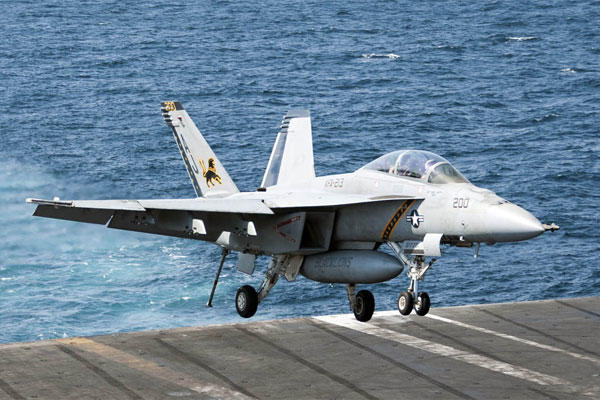U.S. and coalition warplanes have stepped up the air campaign against the Islamic State of Iraq and Syria (ISIS) in recent weeks, boosting the number of airstrikes to well over 1,000 since the bombing and missile attacks began on Aug. 8, Pentagon officials said.
Through Nov. 19, a total of 1,006 airstrikes were conducted – 561 against targets in Iraq and 445 in Syria, the officials said. The U.S. flew 843 of the missions and allies flew 163.
The airstrikes have hit a total of more than 2,300 ISIS targets, including 700 ISIS-occupied buildings, 380 fighting positions, 260 vehicles and 180 “black market oil-related targets,” the officials said.
Since Nov. 19, an additional 71 airstrikes have been carried out in Operation Inherent Resolve, bringing the total to 1,077, according to U.S. Central Command.
In the most recent attacks from Nov. 24-26, bomber and fighter aircraft conducted 10 airstrikes against ISIS targets in Syria, and attack, fighter and remotely-piloted aircraft carried out attack missions in Iraq.
In a statement, CentCom said that the 10 airstrikes in Syria were focused on the area around Kobani, the northeastern Syrian town close the Turkish border where Kurdish forces have been under siege from ISIS for more than two months. The strikes near Kobani struck an ISIS fighting position and two tactical units, and destroyed four ISIS staging areas and six fighting positions, CentCom said.
Several allies have limited themselves to airstrikes only in Iraq or Syria. Australia, Belgium, Canada, Denmark, France, Netherlands and Britain have agreed to contribute to the air campaign in Iraq. Bahrain, Jordan, Saudi Arabia, and the United Arab Emirates have joined the U.S. in attacks in Syria.
The U.S. strikes have mostly been conducted by Air Force jet flying from airfields in the region. The U.S. has been pressing for use of the huge Incirlik airbase in Turkey, but Turkey has thus far refused to grant permission for U.S. aircraft to carry out attacks from its territory.
Navy and Marine jets flying off the carrier USS Carl Vinson in the Persian Gulf have also carried out airstrikes. The Vinson replaced the carrier George H.W. Bush in the Gulf on Oct. 19.
The campaign against ISIS has been costing about $8 million daily since President Obama authorized increasing the troop presence in Iraq last June, according to the Pentagon.
Last month, Obama asked Congress in the lame-duck session to approve $5.6 billion in funding from the budget for Overseas Contingency Operations to pay for sending an additional 1,500 training and advisory troops to Iraq, boosting the U.S. troop presence to about 3,100.
-- Richard Sisk can be reached at richard.sisk@monster.com





























